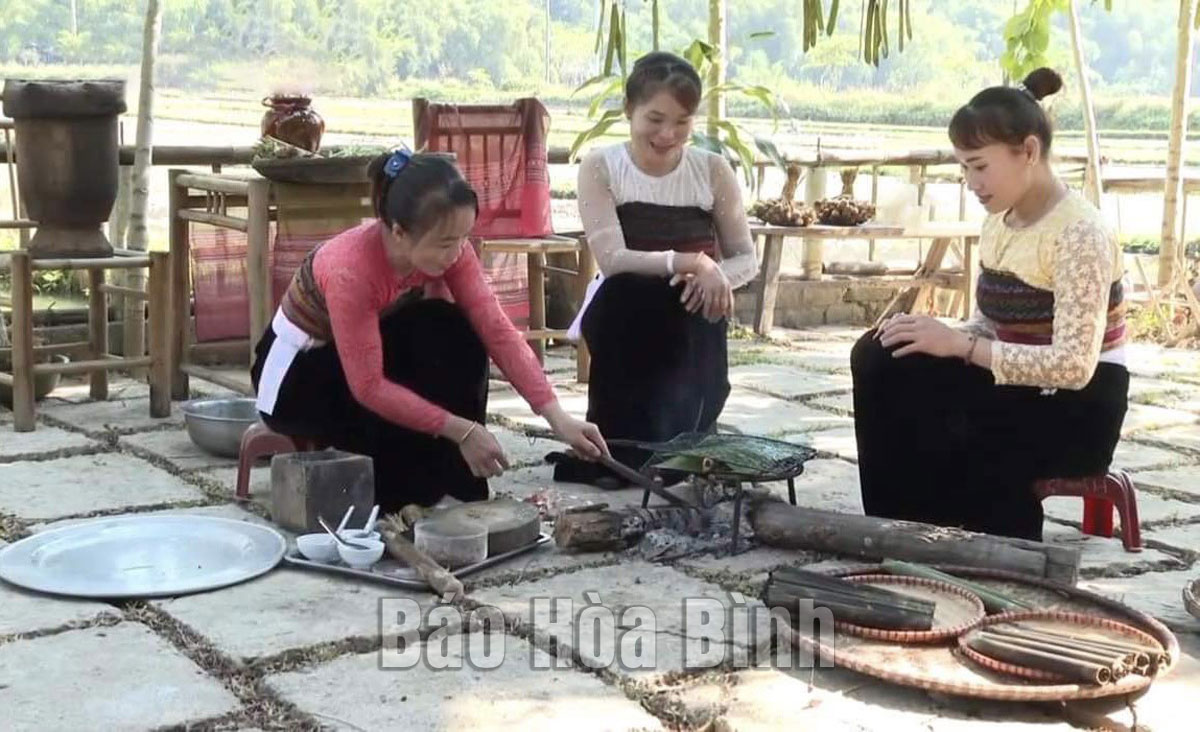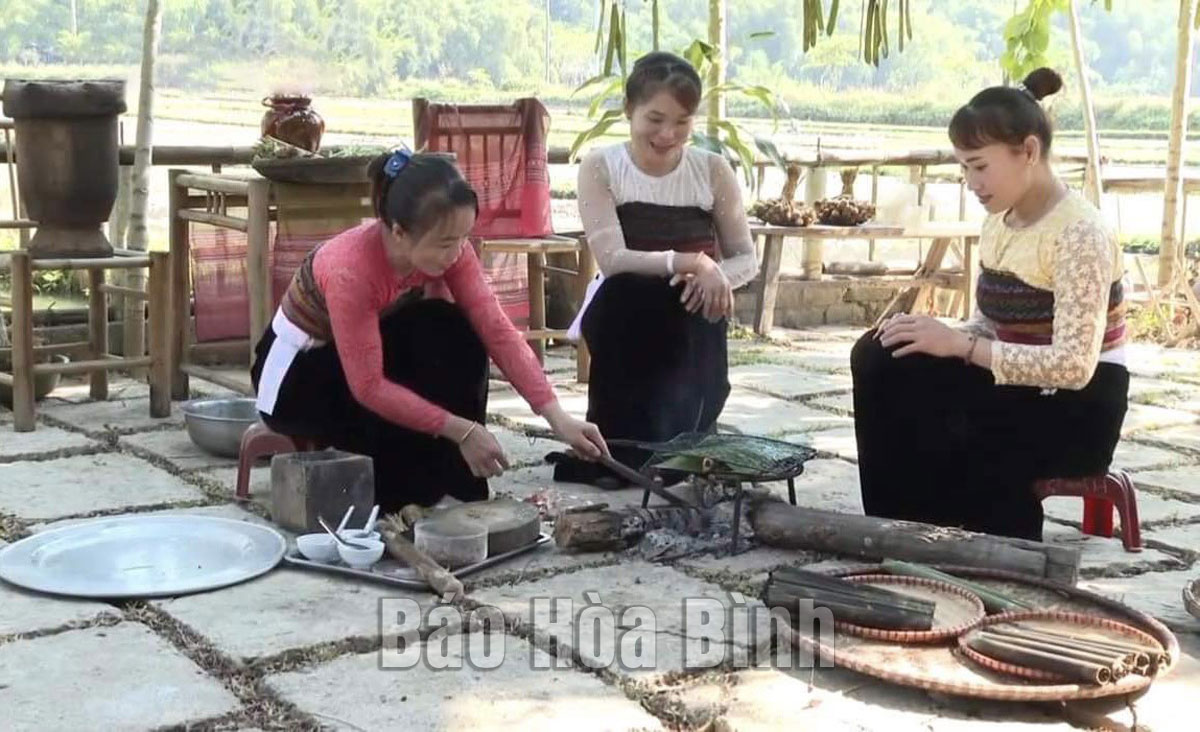
(HBO) - On the first days of the year, I went back to a beautiful land. There is a dish that enters the beautiful verses: "Mai Chau smells the sticky rice even if in women”. Even the sticky rice is as salty and seductive as Thai women themselves!
Thai ethnic women in Chieng Chau commune (Mai Chau) are prepare ingredients to make the traditional rice, Lam.
Going from the town to Da Trang Pass, people cannot help "falling in love” with the beautiful natural scenery which is like the paradise. Stop by a small stall with the fragrant sticky rice grown on the highland, it's easy to fall in love and it seems like you don't want to leave! When the hot smoke emits with a gentle fragrance, we can feel the quintessence of the cuisine of Thai ethnic people in the Northwest in this dish. Each grain of rice is stretched and shiny, naturally colored from leaves with eye-catching colors.
Being fascinated and curious how to create five-color sticky rice of Thai people, we went to Chieng Chau commune. Ms. Kha Thi Luan was born and raised on this land, so she knows all the secrets to cook the typical Thai dishes. We visited her house at the right time when she was dyeing rice for food, preparing for the family's year-end reunion meal, Ms. Luan said: Five-color sticky rice is an indispensable traditional dish in Thai rice trays, especially during the holidays and Tet of the Thai people in Mai Chau. To make the colorful sticky rice, it is necessary to choose a delicious variety of sticky rice grown on the terraced fields of the valley and it must be undergone the meticulous processing steps. After being soaked for many hours, the rice is dyed and then brought to the wooden pallet to be steamed twice. It is well-done for the first time, stir well, and the sticky rice is made softer and more flexible for the second time. The color of the sticky rice also has special meanings: The red represents the abundance, the yellow represents fullness, the purple is faithful, the white represents the pure love, and the blue is the color of the mountain in the Northwest forests.
Enjoying the upland sticky rice, you can have it with the grilled chicken raised on the hills, the grilled skewer pork or juicy stream fish. Even, there is no need to be so sophisticated, simply enjoying it with a bowl of sesame salt is enough to make the "ecstatic” taste.
Not only the sticky rice, the traditional dishes of Thai ethnic people show the combination and harmony with the spirit of the mountains and the simple humanity. For them, cuisine is an art that has become a deep and traditional cultural feature. According to Ms. Luan, to welcome the new year with lots of luck, Thai families bring areca nut and betel leaves inviting the village shaman to worship the ancestors, ward off the evil spirits and ask for good things from lunar December 24th to 26th. As the shaman is always respected most in the village in the Thai people's concept. The shaman can talk to the yin people, sending the best wishes of the existing peopel to the ancestors. For them, these days are an occasion to show the filial piety to the died people.
Normally, Thai dishes are divided into 5 different parts such as: Cham Cam (the dipping sauce is placed first); Cam Nam (the drinks are placed second); Cam Cap (the junk food is placed third); Cam Kin (the food is placed fourth); Cam Khau (the rice is put last). Appearing on the tray of rice on the last day of the year, there are also other special traditional dishes such as: grilled fish, dried meat, wild vegetables, bee pupa... All the dishes are made from the completely raw natural material, which is carefully marinated. In particular, the typical spice used by Thai people to marinate is "Mac Khen” (the wild pepper). A unique feature of Thai cuisine is that when cooking the dish they do not completely use the fat or the cooking oil, the cook carefully focuses on marinating with the spices in a suitable and harmonious way to create the dishes that are both delicious and attractive, attracting the enthusiasts of the traditional ethnic cuisine.
With an increasingly vibrant and widespread emulation movement aimed at building cultured residential areas and cultured families, Yen Thuy District has been making steady progress toward improving both the material and spiritual well-being of its people, while fostering a civilized, prosperous, beautiful, and progressive community.
Once lacking recreational spaces and community facilities, Residential Group 2 in Quynh Lam Ward (Hoa Binh City) has recently received attention for the construction of a new, spacious, and fully equipped cultural house. The project followed the model of state support combined with public contributions in both labor and funding.
The "All people unite to build cultural life" movement, which has been effectively integrated with Kim Boi district’s socio-economic development goals, is fostering a lively spirit of emulation across local residential areas, hamlets, villages, public agencies, and enterprises. In addition, through the initiative, traditional cultural values are being preserved and promoted, while community solidarity and mutual support in poverty reduction and economic development are being strengthened.
A working delegation of the Hoa Binh provincial People’s Committee led by its Permanent Vice Chairman Nguyen Van Toan on June 11 inspected the progress of a project to build the Mo Muong Cultural Heritage Conservation Space linked to tourism services in Hop Phong commune, Cao Phong district.
Born and growing in the heroic land of Muong Dong, Dinh Thi Kieu Dung, a resident in Bo town of Kim Boi district, in her childhood was nurtured by the sweet lullabies of her grandmother and mother. These melodies deeply imprinted on her soul, becoming an inseparable part of her love for her ethnic group's culture. For over 20 years, this love for her hometown has driven Dung to research, collect, and pass down the cultural values of the Muong people to future generations.
In the final days of May, the Ethnic Art Troupe of Hoa Binh Province organized performances to serve the people in remote, mountainous, and particularly disadvantaged areas within the province. These were not just ordinary artistic shows, but they were the meaningful journeys aimed at spreading cultural values, enhancing the spiritual life of the people and contributing to the preservation of ethnic minority cultural identities.



